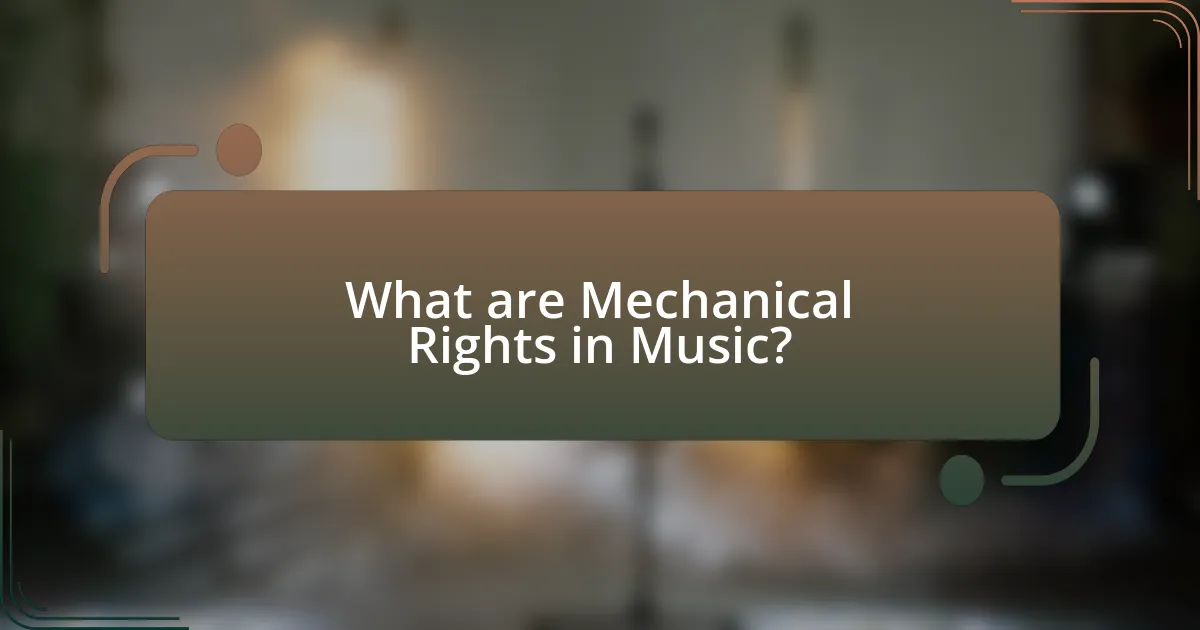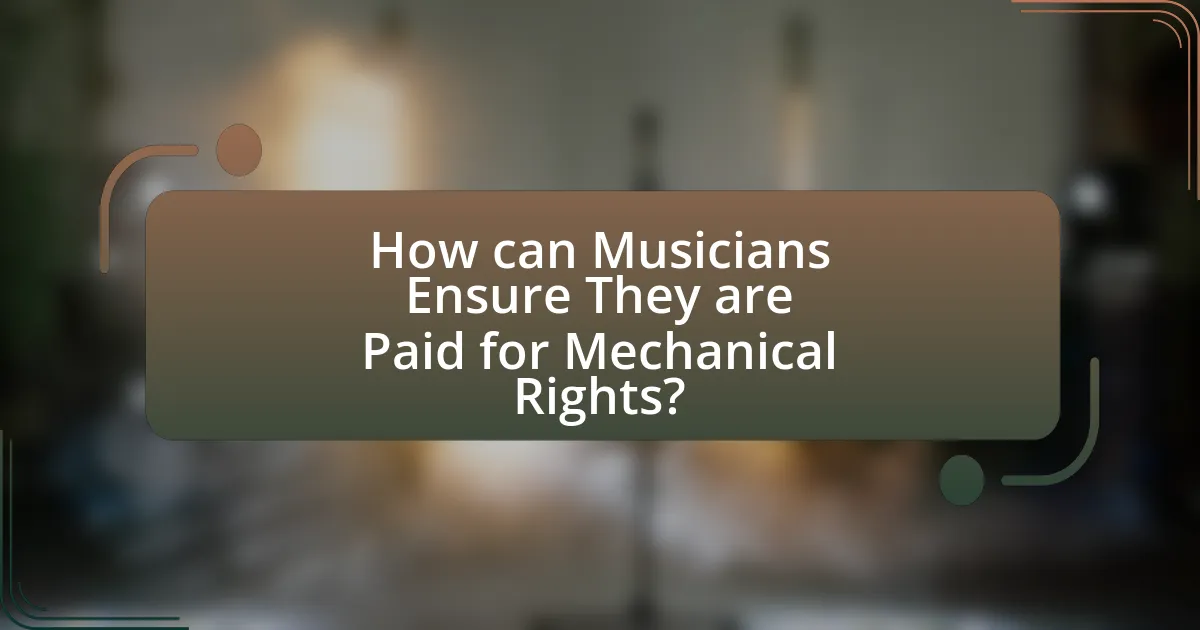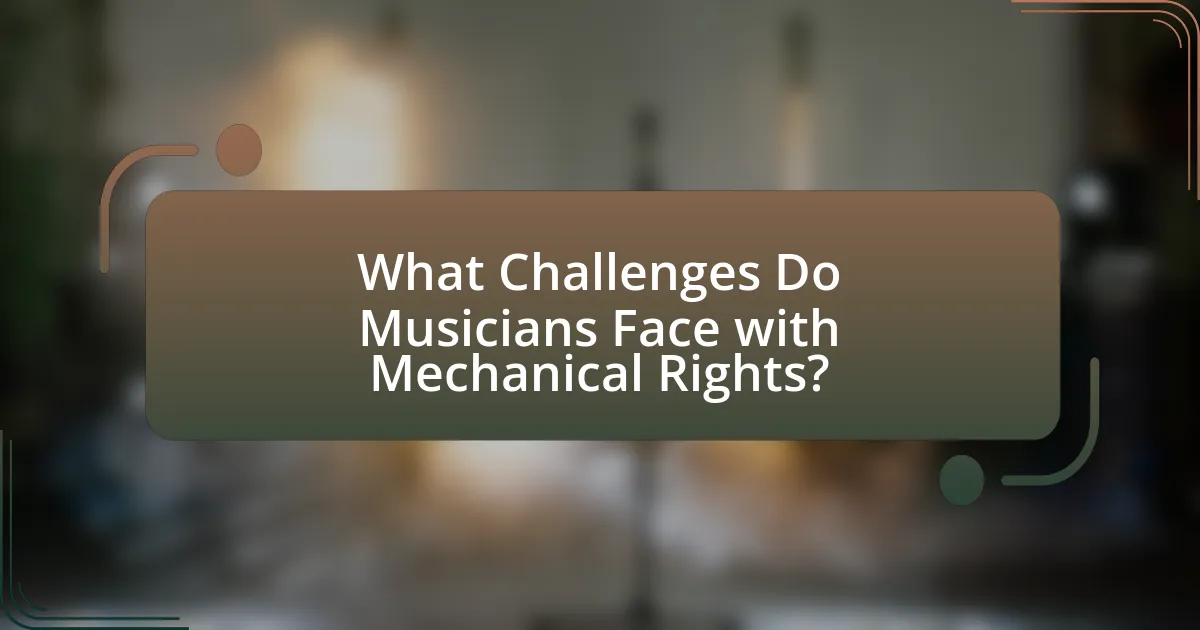Mechanical rights in music are essential for songwriters and publishers, granting them the ability to reproduce and distribute their compositions in physical and digital formats, such as CDs and downloads. Governed by the U.S. Copyright Act of 1976, these rights ensure that creators receive royalties for their work, currently set at 9.1 cents per song per copy. The article explores the differences between mechanical rights and other music rights, the significance of these rights for music creators, and the steps musicians can take to secure and manage their mechanical rights effectively. It also addresses common challenges, legal issues, and best practices for tracking earnings and advocating for fair compensation in the evolving music industry landscape.

What are Mechanical Rights in Music?
Mechanical rights in music refer to the rights granted to reproduce and distribute a musical composition in physical or digital formats, such as CDs, vinyl records, and downloads. These rights allow songwriters and publishers to earn royalties whenever their music is reproduced, ensuring they are compensated for the use of their creative work. In the United States, mechanical rights are governed by the Copyright Act of 1976, which mandates that a statutory mechanical royalty rate be paid to copyright holders for each copy sold, currently set at 9.1 cents per song per copy for physical formats and digital downloads. This framework ensures that artists receive fair compensation for their contributions to the music industry.
How do Mechanical Rights differ from other music rights?
Mechanical rights specifically pertain to the reproduction of a musical composition in physical or digital formats, such as CDs or downloads, while other music rights, like performance rights and synchronization rights, relate to different uses of the music. Mechanical rights grant the right to reproduce and distribute the music, typically requiring a license and payment of royalties to the songwriter or publisher, as established by the U.S. Copyright Act of 1976. In contrast, performance rights cover the public performance of music, requiring separate licensing through organizations like ASCAP or BMI, and synchronization rights involve the use of music in audiovisual works, necessitating agreements with the copyright holder.
What are the key components of Mechanical Rights?
The key components of Mechanical Rights include the right to reproduce a musical composition in physical formats, the right to distribute those reproductions, and the right to receive royalties from such reproductions. Mechanical Rights specifically pertain to the licensing of music for reproduction on CDs, vinyl, and digital downloads, ensuring that songwriters and publishers are compensated for the use of their work. In the United States, the Music Modernization Act of 2018 further clarified these rights, establishing a framework for mechanical licensing and ensuring that songwriters receive fair compensation for their compositions.
Why are Mechanical Rights important for music creators?
Mechanical rights are important for music creators because they ensure that artists receive compensation for the reproduction of their music in physical formats and digital downloads. These rights allow creators to earn royalties whenever their compositions are reproduced, which is essential for their financial sustainability. For instance, in the United States, the Music Modernization Act of 2018 established a framework for mechanical royalties, highlighting their significance in the music industry. This legal recognition underscores the necessity for music creators to secure their mechanical rights to protect their income and creative work.
What types of works are covered under Mechanical Rights?
Mechanical rights cover musical compositions, specifically the right to reproduce and distribute a song in physical formats such as CDs, vinyl, and digital downloads. These rights apply to the underlying musical work, including the melody, lyrics, and arrangement, allowing for the creation of copies for sale or distribution. The U.S. Copyright Act of 1976 established these rights, ensuring that songwriters and publishers receive compensation when their works are reproduced.
How do Mechanical Rights apply to physical and digital formats?
Mechanical rights grant songwriters and publishers the right to receive payment when their music is reproduced in physical formats, such as CDs and vinyl, as well as in digital formats, including downloads and streaming services. In physical formats, mechanical royalties are typically generated through the sale of copies, with rates established by organizations like the Harry Fox Agency in the U.S., which sets the statutory rate at 9.1 cents per copy for songs under five minutes. In digital formats, mechanical rights apply to downloads and interactive streaming, where services like Spotify and Apple Music pay mechanical royalties based on the number of streams or downloads, calculated through agreements with music publishers. This ensures that creators are compensated for the reproduction of their work across both physical and digital mediums.
What is the significance of cover songs in relation to Mechanical Rights?
Cover songs are significant in relation to Mechanical Rights because they require the payment of royalties to the original songwriters when the cover is distributed. Mechanical Rights grant the copyright holder the right to receive compensation for the reproduction of their work, which includes cover versions. According to the U.S. Copyright Act, a mechanical license is necessary for anyone wishing to record and distribute a cover song, ensuring that the original creators are compensated for their intellectual property. This legal framework supports the music industry by promoting fair compensation and encouraging the creation of new interpretations of existing works.

How can Musicians Ensure They are Paid for Mechanical Rights?
Musicians can ensure they are paid for mechanical rights by registering their works with a performance rights organization (PRO) and a mechanical rights organization, such as the Harry Fox Agency or Music Reports. By doing so, musicians establish a legal claim to royalties generated from the reproduction of their music, which is mandated by copyright law. According to the U.S. Copyright Office, mechanical royalties are owed to songwriters and publishers whenever their music is reproduced, whether in physical formats like CDs or digital formats like downloads and streaming. Additionally, musicians should actively monitor their sales and licensing agreements to ensure accurate reporting and payment of these royalties.
What steps should musicians take to register their Mechanical Rights?
Musicians should register their Mechanical Rights by first joining a performance rights organization (PRO) or a mechanical rights organization, such as the Harry Fox Agency or Music Reports. After joining, musicians must submit their song information, including title, writer, and publisher details, to the organization. This registration ensures that they receive royalties for the reproduction of their music. Additionally, musicians should keep accurate records of their works and any licensing agreements to facilitate royalty collection. This process is essential as it allows musicians to legally enforce their rights and receive compensation for their creative work.
How do you choose the right organization for rights management?
To choose the right organization for rights management, evaluate the organization’s reputation, services offered, and fee structure. Reputable organizations often have a proven track record of effectively managing rights and ensuring timely payments to their members. Services should align with your specific needs, such as mechanical licensing, performance rights, or digital distribution. Additionally, understanding the fee structure is crucial; organizations that charge lower fees may offer less comprehensive services. Researching member testimonials and industry reviews can provide insights into the organization’s reliability and effectiveness in managing rights, ensuring that you receive fair compensation for your music.
What documentation is necessary for claiming Mechanical Rights?
To claim Mechanical Rights, the necessary documentation includes a completed mechanical license application, proof of ownership of the musical work, and a copy of the song or recording for which the rights are being claimed. The mechanical license application typically requires details such as the title of the work, the name of the songwriter, and the intended use of the music. Proof of ownership can be established through copyright registration or a publishing agreement. These documents are essential for ensuring that the rights holder is recognized and compensated for the use of their music, as outlined in the U.S. Copyright Act, which governs mechanical rights.
How can musicians track their Mechanical Rights earnings?
Musicians can track their Mechanical Rights earnings by utilizing performance rights organizations (PROs) and music publishing companies that manage these rights. These organizations, such as ASCAP, BMI, and SESAC in the United States, provide detailed statements and reports on earnings from mechanical royalties, which are generated from the reproduction of their music. Additionally, musicians can use digital distribution platforms like TuneCore or CD Baby, which often include tracking features for mechanical royalties. These platforms provide insights into sales data and earnings, allowing musicians to monitor their income effectively.
What tools and resources are available for tracking earnings?
Tools and resources available for tracking earnings include digital distribution platforms, performance rights organizations, and music publishing administration services. Digital distribution platforms like DistroKid and TuneCore provide artists with detailed earnings reports from streaming services and sales. Performance rights organizations, such as ASCAP and BMI, track public performances and collect royalties on behalf of artists, offering transparency in earnings. Additionally, music publishing administration services like Songtrust help manage and track mechanical royalties, ensuring that artists receive payments for their compositions. These resources collectively enhance an artist’s ability to monitor and optimize their earnings in the music industry.
How can musicians identify potential unpaid Mechanical Rights?
Musicians can identify potential unpaid Mechanical Rights by regularly auditing their music distribution and sales data. This involves tracking the number of copies sold and ensuring that all mechanical royalties are accounted for, as per the statutory rates set by copyright law. For instance, the U.S. Copyright Office mandates that songwriters receive a mechanical royalty of 9.1 cents per copy for physical and digital sales. By comparing sales figures from platforms like Spotify, Apple Music, and physical sales reports against expected royalty payments, musicians can pinpoint discrepancies that may indicate unpaid mechanical rights. Additionally, utilizing services like the Harry Fox Agency can help musicians monitor and collect these royalties effectively.

What Challenges Do Musicians Face with Mechanical Rights?
Musicians face several challenges with mechanical rights, primarily related to the complexities of licensing and revenue collection. The mechanical rights system requires musicians to navigate various licensing agreements, which can be confusing and time-consuming. Additionally, many musicians struggle to receive fair compensation due to inadequate tracking of music usage and the distribution of royalties. According to the U.S. Copyright Office, mechanical royalties are often mismanaged, leading to significant revenue losses for artists. Furthermore, the rise of digital streaming platforms has complicated the landscape, as traditional mechanical rights do not always apply, resulting in further financial uncertainty for musicians.
What common pitfalls should musicians avoid regarding Mechanical Rights?
Musicians should avoid the common pitfalls of neglecting to register their works with a mechanical rights organization and failing to understand the licensing process. Neglecting registration can lead to lost royalties, as unregistered works are not tracked for mechanical royalties. Additionally, misunderstanding the licensing process can result in unauthorized use of their music, which can diminish potential earnings. According to the U.S. Copyright Office, mechanical rights are essential for ensuring that musicians receive payment for the reproduction of their music, highlighting the importance of proper management and understanding of these rights.
How can misunderstandings about Mechanical Rights impact earnings?
Misunderstandings about Mechanical Rights can significantly reduce earnings for artists and songwriters. When creators are unaware of their rights to receive royalties from the reproduction of their music, they may fail to license their work properly, resulting in lost income. For instance, the U.S. Copyright Office states that songwriters are entitled to mechanical royalties whenever their music is reproduced, whether in physical formats like CDs or digital formats like downloads. If artists do not understand this, they may not pursue necessary agreements with record labels or streaming services, leading to uncollected royalties. Additionally, incorrect assumptions about the scope of Mechanical Rights can lead to disputes and legal issues, further complicating revenue streams.
What legal issues might arise concerning Mechanical Rights?
Legal issues concerning Mechanical Rights primarily include unauthorized reproduction, licensing disputes, and royalty collection challenges. Unauthorized reproduction occurs when a party uses a musical work without obtaining the necessary mechanical license, violating copyright law. Licensing disputes can arise when there is ambiguity regarding the terms of the mechanical license, leading to disagreements between songwriters, publishers, and record labels. Additionally, challenges in royalty collection may occur due to improper tracking of sales or distribution, resulting in artists not receiving the payments they are owed. These issues highlight the complexities of managing Mechanical Rights in the music industry.
How can musicians effectively advocate for their Mechanical Rights?
Musicians can effectively advocate for their Mechanical Rights by actively engaging with performance rights organizations and ensuring proper registration of their works. By joining organizations like the American Society of Composers, Authors, and Publishers (ASCAP) or Broadcast Music, Inc. (BMI), musicians gain access to resources that help them understand and enforce their rights. Additionally, registering their compositions with these organizations ensures that they receive royalties for mechanical reproductions, as these entities monitor and collect payments on behalf of their members. According to the U.S. Copyright Office, mechanical rights are a legal entitlement that allows songwriters to receive compensation when their music is reproduced, highlighting the importance of proper advocacy and registration in securing these rights.
What strategies can be employed to negotiate better terms?
To negotiate better terms, artists should employ strategies such as thorough preparation, understanding market standards, and leveraging competition. Preparation involves researching the specific mechanical rights and payment structures relevant to their music, which allows artists to present informed arguments during negotiations. Understanding market standards helps artists establish a baseline for what constitutes fair compensation, as evidenced by industry reports indicating average mechanical royalty rates. Leveraging competition can create urgency and motivation for the other party to offer better terms, as demonstrated by cases where artists have successfully negotiated higher rates by showcasing interest from multiple labels or publishers.
How can collaboration with industry professionals enhance rights management?
Collaboration with industry professionals enhances rights management by leveraging their expertise and networks to streamline processes and ensure compliance. Industry professionals, such as music publishers and legal advisors, possess in-depth knowledge of copyright laws and licensing agreements, which can help artists navigate complex rights issues more effectively. For instance, a study by the International Confederation of Societies of Authors and Composers (CISAC) highlights that collaboration leads to improved revenue collection and distribution, as professionals can identify and secure royalties that independent artists might overlook. This partnership ultimately results in better protection of intellectual property and maximizes financial returns for creators.
What are the best practices for managing Mechanical Rights?
The best practices for managing mechanical rights include registering your works with a performance rights organization, ensuring accurate metadata for your music, and regularly monitoring royalty statements. Registering with organizations like the Harry Fox Agency or Music Reports helps secure your rights and facilitates royalty collection. Accurate metadata, including song titles, writers, and publishers, is crucial for proper identification and payment. Monitoring royalty statements allows you to identify discrepancies and ensure you receive the correct payments for your works. These practices are essential for maximizing revenue and protecting your intellectual property in the music industry.
How can musicians stay informed about changes in Mechanical Rights laws?
Musicians can stay informed about changes in Mechanical Rights laws by subscribing to industry newsletters, joining professional organizations, and following relevant legal blogs. Industry newsletters, such as those from the American Music Publishers Association, provide updates on legislative changes and industry standards. Professional organizations like ASCAP and BMI often host workshops and webinars that cover legal updates. Additionally, legal blogs focused on music law, such as the Music Law Blog, offer insights and analyses of new developments in Mechanical Rights legislation. These resources ensure musicians receive timely and accurate information regarding their rights and obligations.
What resources are available for ongoing education about Mechanical Rights?
Resources for ongoing education about Mechanical Rights include the American Society of Composers, Authors and Publishers (ASCAP), which offers webinars and workshops on copyright issues, and the National Music Publishers’ Association (NMPA), which provides educational materials and resources on mechanical licensing. Additionally, the Music Publishers Association (MPA) offers seminars and publications focused on mechanical rights. These organizations are recognized for their expertise in music rights and provide valuable information to help individuals understand and navigate the complexities of mechanical rights in the music industry.